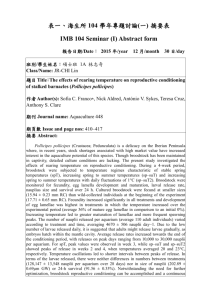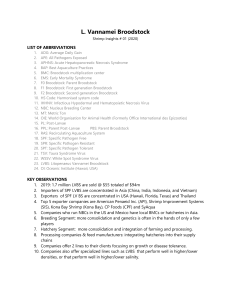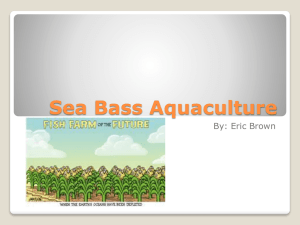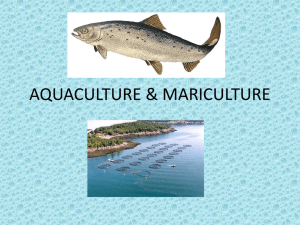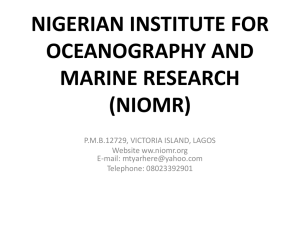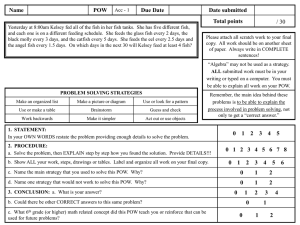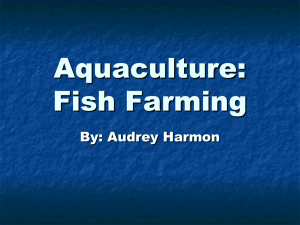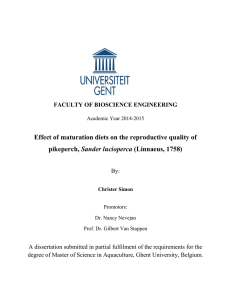PPT - Aquaculture Asia
advertisement
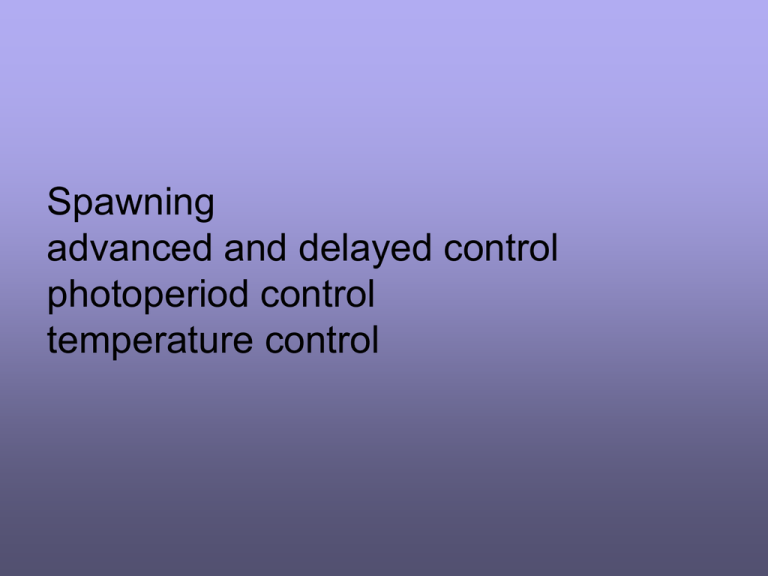
Spawning advanced and delayed control photoperiod control temperature control Photoperiod control Day Length and Temperature Advancing or delaying spawning From Broodstock management and selective breeding Yonathan Zohar 22 20 18 16 14 12 10 Dec15-31 Oct15-31 Aug15-31 Jun 15-30 Apr15-30 Feb15-28 Dec15-31 Oct15-31 Aug15-31 Jun 15-30 Apr15-30 Feb15-28 Dec15-31 Oct15-31 Aug15-31 Jun 15-30 Apr15-30 Feb15-28 Month Temperature 24 17 16 15 14 13 12 11 10 9 8 7 6 Photoperiod Advanced bass photoperiod Broodstock conditioning systems 50,000 liter 95% recirculating Artificial substrate Photoperiod control Water temperature control NATURAL SPAWN Lunar cycle 1400 27 800 25 600 23 400 21 200 19 Date FULL MOON Wt. Range Avg. Weight Avg. FL 6 MALES 4 – 8 kg. 6 kg. 62.8 cm. 6 FEMALES 4.5 – 8.75 kg. 7.1 kg. 64 cm. 15-Oct 11-Oct 7-Oct 3-Oct 29-Sep 25-Sep 21-Sep 17-Sep 13-Sep 9-Sep 5-Sep 1-Sep 28-Aug 24-Aug 20-Aug 16-Aug 12-Aug 8-Aug 4-Aug 31-Jul 0 27-Jul No. of eggs (x 1000) 1000 Water Temperature (C) 29 1200 Broodstock tanks with natural temperatures Egg and larval production A recent extended genetic study (Cameron Brown R. et al, 2005) carried out at Stirling on a commercial gilthead sea bream hatchery discovered that: • the effective breeding population was consistently low (26 to 32% of the broodstock population) • the individual contribution to spawning was highly variable, especially for males • larger and smaller broodstock in weight had a reduced reproductive success compared to the performances of fish at the mean size This information is undoubtedly of interest for hatchery managers….. Broodstock Nutrition Feeding (Pellets, trash fish) Feed supplements (Vit E, HUFA’s) Broodstock nutrition Egg quality is a function of broodstock nutrition – Enriching broodstock feed with oils • omega 3 – Enriching broodstock feed with vitamins • Vitamin C • Vitamin E – Feeding with natural feeds once per week • squid • mussels • fish Broodstock nutrition plays important role on: • Reproductive behaviour – Essential nutrients for gonadal development • Reproductive performance – Egg size, larval size, timing of reproductive season, spawning frequency – Fecundity, gametogenesis, gamete quality • Egg and larval quality – Endogenous supply of essential nutrients • Larval capacity to switch to artificial diets • Overall hatchery performance Criteria for broodstock diet formulation – catfish - Pangasius • Total protein : 35-40 % ; Total lipids : 5-10 % (% dry matter), • Use of diverse ingredient sources – use several primary matters sources (example, for the protein : soy meal / fish meal / meat meal), • Glucidic ingredients should be 20-30 % to cover the energy requirements and ensure a diet that is well bound • Add a premix containing essential nutrients, trace minerals and vitamins Dietary requirements - often unknown • Protein requirement for optimal reproductive performance will vary with species, size, dietary protein and energy sources and rearing system – Tilapia – 30-40% protein P/E ratio 23.6g/MJ – Channel catfish 28-35% protein • Mineral content of salmonid feed Concentration high Bioavailability low Cd Cr Ni Mg Na Co Pb Cu Mn K P Zn Fe Ca 0 10 20 30 g/kg of feed 40 50 0.1 1 10 mg/kg of feed 100 1000 Effect of broodstock nutrition on embryo development • Vitamin A, E and C – Important for embryo and larval development • Suboptimal levels result in – Low embryonic survival – Reduced larval survivals – Increased developmental abnormalities Effect of lipid manipulation in broodstock diets • Lipids – fats & fatty acids Play an essential role in reproductive maturity and gonadal development in fish through lipid mobilization from the liver and muscle to developing gonads Vital for normal embryionic and larval development • Deficiencies or unbalanced diet – Reduced egg viability and sperm quality – Low embryionic survival – Embryionic malformations • Freshwater species Salmonidae, Cyprinidae, Catfish and eel need 18:2(n-6) and 18:3 (n-3) (linolenic acid) fatty acids due to their ability to elongate and desaturate 18-carbon fatty acids • Marine species need more elongated and unsaturated FA EPA 20:5(n-3) and DHA - 22:6(n-3) • Arachidonic acid 20:4 (n-6) is also required in some species as it stimulate reproductive hormone production and courtship behaviour USE OF TRASHFISH • Availability? Freshness? Stable quality? • Unpractical and risk of water pollution • Deficiency for some nutrients • Risk of spreading viral or bacterial diseases among the valuable broodstock animals Broodstock diet issues – Asia • Objective - Optimal broodstock conditioning • Feeds – ‘trash’ fish use – need for cost-effective grow-out and broodstock diets Commercial diets Innovative breed concept for marine broodstock, available in three different formulations • Lansy Breed Maturation: soft maturation pellet enhancing the nutritional quality of the offspring • Lansy Breed Recovery: soft recovery pellet facilitating recuperation after intensive spawning • Lansy Breed Pause: maintenance diet for optimal balance in nutrition and economics during the broodstock's resting and preparatory phase • consistent, high quality concentrate for moist broodstock feeds Broodstock vaccination Vaccination response FISH • Teleost fish have a number of adaptive immune responses and immune memory, involving B cells and T cells, antibody and phagocytic cells. • This adaptive immune response enables them to specifically “remember” exposure to pathogens and respond with increased efficiency on subsequent encounters, forming the basis of vaccination • Understanding of these immune mechanisms and how the pathogens interact has allowed the development of successful vaccines. Vaccination in finfish • Major success story in 1990’s in salmon farming • Part of an overall health programme to prevent disease infection • All effective vaccines for farmed fish are injectable and oil adjuvanted • Aqueous immersion vaccines – limited duration of immunity and variable efficacy – Used for juvenile stages to offer protection prior to injection • Oral vaccines – available commercially – variable success as primary immunogens Vaccines available in Asia - Intervet Product Description Aquavaccol TM Licensed as an aid in the prevention of columnaris disease in channel catfish Aquavac-Esc® Vaccine against Enteic septicemia Norvax ® Strep Si Vaccine against streptococcal disease in susceptible fish species like Asia seabass Norvax® Vibrio mono Vaccine against vibriosis in yellowtail While the concept of vaccines is new to farmers in Asia this may change due to increased awareness of food safety issues and the availability of vaccine products Specific Pathogen Free (SPF) Broodstock Wild broodstocks • Worldwide many hatcheries and ongrowing facilities are wholly dependant on wild caught broodstock • Disease risk Study in Malaysia (2006) indicated that 70% of wild black shrimp broodstock were infected or were carriers with one or more pathogenic viruses Viral pathogens • • • • • • • White spot syndrome virus (WSSV) Taura syndrome virus (TSV) Monodon baculovirus (MBV) Yellow head virus (YHV) Hepatopancreatic parrovirus (HPV) Koi herpesvirus (KHV) Large mouth bass virus (LMBV) Specific Pathogen Free (SPF) Broodstock • This is a dynamic process • Indicates present pathogen status • Function of – Reliable non-lethal pathogen diagnosis PCR / RT-PCR – Ability to physically exclude pathogen from the facilities – Pose a significant threat to the industry SPF & Biosecurity • SPF status is a function of level of biosecurity in the facilities where species are cultured • Physical isolation – Enclosed facility • Exclusion of water and air borne disease vectors – Recirculation systems & control of water quality – Effective water treatment – Air conditioning systems • Additional factors – Minimised handling – Optimised nutrition Development of SPF broodstock • Primary quarantine – elimination of contaminated or carrier broodstock – Rigorous broodstock screening – Individual tanks – Tagging • Fish– pit tags / branding • Shrimp – VIE (Visible Interior Elastomer) • Secondary quarantine – maturation and larval rearing facilities – Avoidance of cross contamination – Restricted movements • On-growing facilities for broodstock development – F1 generation production parameters generally decreased cf offspring wild broodstock – Subsequent generations – production performance improved Tagging • Mark with PIT-TagsTM • (PIT = Passive Internal Transponder) • Read the tags electronically. • The tag is a small capsule of 10 mm x 2. • It is injected into the dorsal muscle or under the skin of an anethetised fish • The fish is identified by a 10 digit number.
